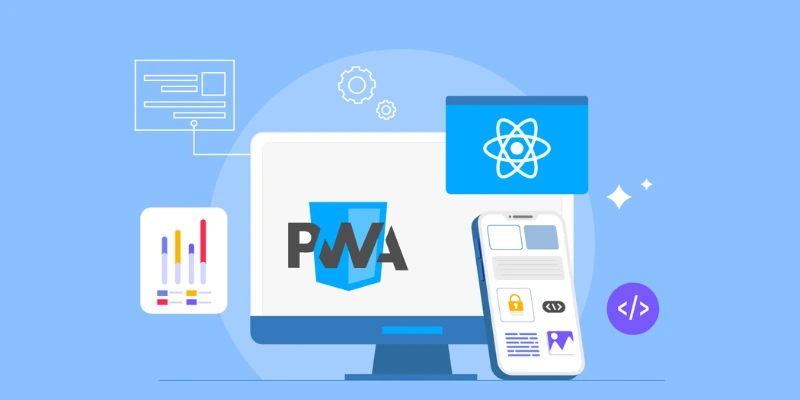
Progressive Web Apps (PWAs) combine the best features of web and mobile applications, offering fast, reliable, and engaging experiences. They function like native apps but are accessible via web browsers, eliminating the need for app store installations. With React, a powerful JavaScript library for building user interfaces, developing PWAs becomes efficient and scalable.
In this guide, we will explore the process of building a PWA using React, covering essential aspects such as service workers, caching strategies, and manifest files. If you are looking for structured guidance, enrolling in a React JS Training in Chennai can help enhance your skills in building PWAs effectively.
Understanding the Basics of PWAs
PWAs are web applications that provide an app-like experience using modern web technologies. They feature fast load times, offline functionality, and push notifications. Key characteristics include responsiveness, progressive enhancement, and security. They work across different devices and browsers, ensuring a seamless user experience.
React is a preferred choice for building PWAs due to its component-based structure, efficient state management, and vast ecosystem of tools. It simplifies the development process and enhances performance through its virtual DOM capabilities.
Setting Up a React Project for PWA Development
To create a PWA with React, the first step is to set up a project that includes the necessary configurations. Using a structured framework helps streamline development and ensures best practices are followed. The setup process typically involves installing dependencies, structuring the project folder, and defining key configurations. For those looking to enhance their expertise in business process automation, enrolling in Pega Training in Chennai can provide valuable insights alongside React development.
Once the project is set up, it is essential to verify that it includes the required files for PWA functionality. This includes the web app manifest, service worker, and caching mechanisms, which contribute to enhanced performance and offline support.
Configuring the Web App Manifest
A web app manifest is a JSON file that provides metadata about the application, such as its name, icons, theme colors, and display mode. This file allows the PWA to be installed on a user’s device, similar to a native app.
Ensuring that the manifest contains appropriate branding elements, such as high-quality icons and relevant color schemes, improves the app’s visual appeal. Additionally, specifying the display mode as standalone or fullscreen enhances the immersive experience. Integrating Styled Components in React can further enhance the UI design by enabling dynamic theming and modular styling, ensuring a more polished and cohesive user experience.
Implementing Service Workers for Offline Support
Service workers are scripts that run in the background, enabling offline functionality and resource caching. They act as intermediaries between the web application and the network, allowing users to access content even when offline.
Service workers help cache essential assets, such as images, stylesheets, and JavaScript files. This improves loading speed and ensures that the app remains functional during network disruptions. Understanding different caching strategies, such as network-first or cache-first approaches, helps optimize performance based on application requirements.
Enhancing Performance with Caching Strategies
Caching is a critical aspect of PWAs, as it ensures fast load times and reduces server requests. Different caching strategies are used depending on the nature of the application and user interaction patterns. Optimizing Performance in React plays a crucial role in ensuring efficient caching mechanisms, reducing unnecessary re-renders, and improving overall user experience.
A network-first strategy prioritizes fetching the latest content from the network while using cached data as a fallback. Conversely, a cache-first strategy serves stored content before making network requests, enhancing offline performance. Choosing the right strategy ensures a balance between fresh content availability and performance efficiency.
Making the PWA Installable
A key feature of PWAs is their ability to be installed on users’ devices, similar to native apps. This is achieved by ensuring the web app manifest and service workers are correctly configured. Additionally, triggering an installation prompt encourages users to add the app to their home screen.
Providing a clear and engaging install prompt enhances user adoption rates. Ensuring that the app meets browser criteria for installability, such as HTTPS security and a properly structured manifest file, increases the chances of successful installation. Additionally, leveraging the best tools for testing React components ensures that all functionalities work seamlessly before prompting users to install the app.
Testing and Debugging the PWA
Before deploying a PWA, it is essential to conduct thorough testing to ensure optimal functionality. Various tools, such as browser developer tools and performance auditing software, help identify issues and optimize performance.
Testing should focus on verifying offline support, caching behavior, and installability. Simulating different network conditions helps evaluate how the app behaves in real-world scenarios. Debugging tools enable developers to fine-tune configurations and improve overall user experience.
Deploying the PWA
Once testing is complete, the PWA is ready for deployment. Choosing a reliable hosting platform ensures seamless access for users. Popular deployment options include cloud-based hosting services, static site generators, and content delivery networks (CDNs).
Ensuring that the app is deployed with HTTPS security is crucial for PWA functionality. Secure hosting prevents potential security vulnerabilities and ensures compliance with browser requirements. Additionally, understanding the Importance of UI UX in React Applications helps in designing intuitive and accessible interfaces that enhance user engagement and satisfaction.
Building a Progressive Web App with React enables developers to create high-performance, user-friendly applications that work seamlessly across devices and network conditions. By leveraging service workers, caching strategies, and manifest configurations, developers can enhance performance, improve offline support, and provide an app-like experience.
Following best practices in PWA development ensures a robust and scalable application. With continuous advancements in web technologies, PWAs are becoming an essential approach to modern web development. Start implementing these techniques today and elevate your web applications to the next level!
Also Read: Best HR Practices for Onboarding Mobile App Developers
